HPE EC200a Power Consumption and Noise
The unit is powered by a 120W external power brick. That is a lot given the low-power 25W SoC and limited expansion. We wanted to quickly note that unlike on the HPE ProLiant MicroServer Gen10 Plus, there is no retention clip here to keep the PSU retained in the system. As a result, it may be prone to coming out of the receptacle since there is nothing securing the connector.
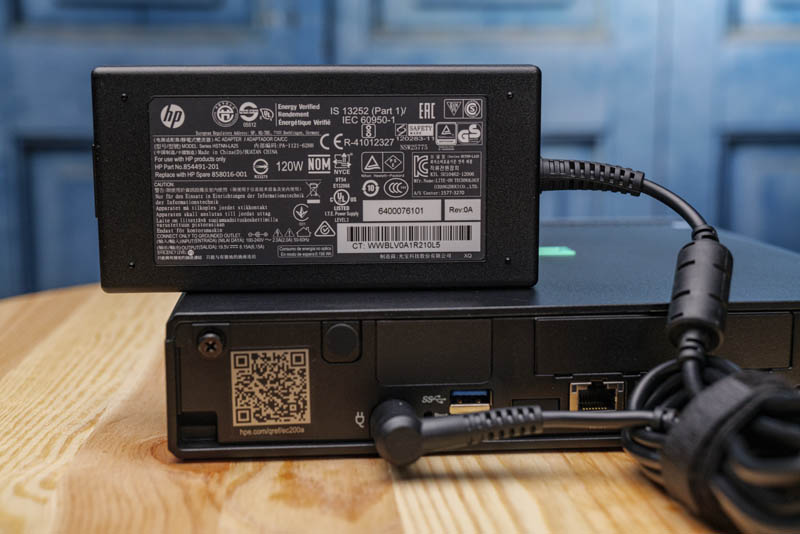
For those that do get the 4-bay expansion chassis, HPE upgrades the power adapter to a 180W unit, which is very similar to what we see on the MicroServer Gen10 Plus.
Still, in our testing, we had idle around 24-27W and maximum power consumption under 60W even with 5400rpm hard drives. However, startup loads with 7200 rpm hard drives may push that higher as may the NIC. We did not have the NIC option to test with.
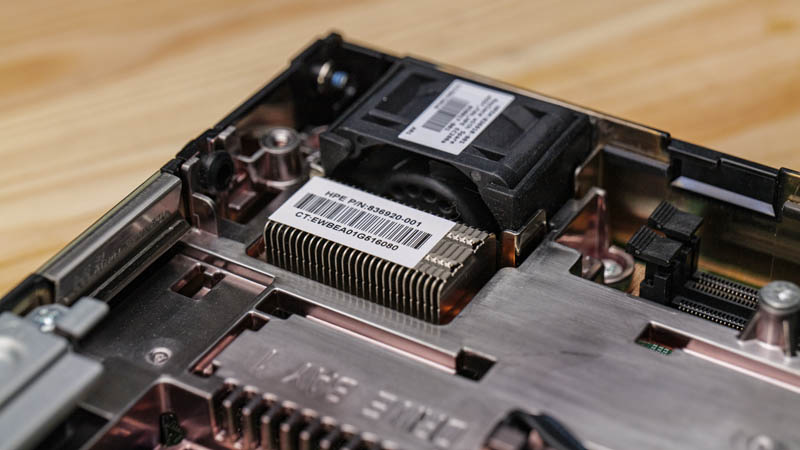
Noise wise we were between 29dba and 36dba on the Extech sound meter. That is neither perfectly silent nor very loud. If you have other equipment running in the same place as the EC200a, it is unlikely to make a noticeable impact.
Market Perspective
In many ways, this is almost a precursor to HPE GreenLake the idea was to get a system installed, with software, that the operating model over the years would be fairly well set. This helps IT buyers forecast costs and create budgets. Instead of purchasing a $20000 up-front server, the model was to have a subscription to make management easy.
It also shows a pretty common theme for HPE. The company struggles mightily trying to deliver solutions for SMB customers outside of Windows. For example, at STH, we tried using ClearOS, decided it was not good enough for our own usage, and shortly thereafter it started being bundled with HPE machines such as the MicroServer Gen10. With ClearOS and HPE both needing to get margin from the sale, the price of ClearOS’s useful features in the SMB space started to way overshadow its usefulness. It leads us to wonder what if HPE had instead leaned into something like a low-cost RHEL/ CentOS or Ubuntu solution for the SMB sector that was very DIY-friendly with huge support ecosystems for those who did not want to do it themselves.
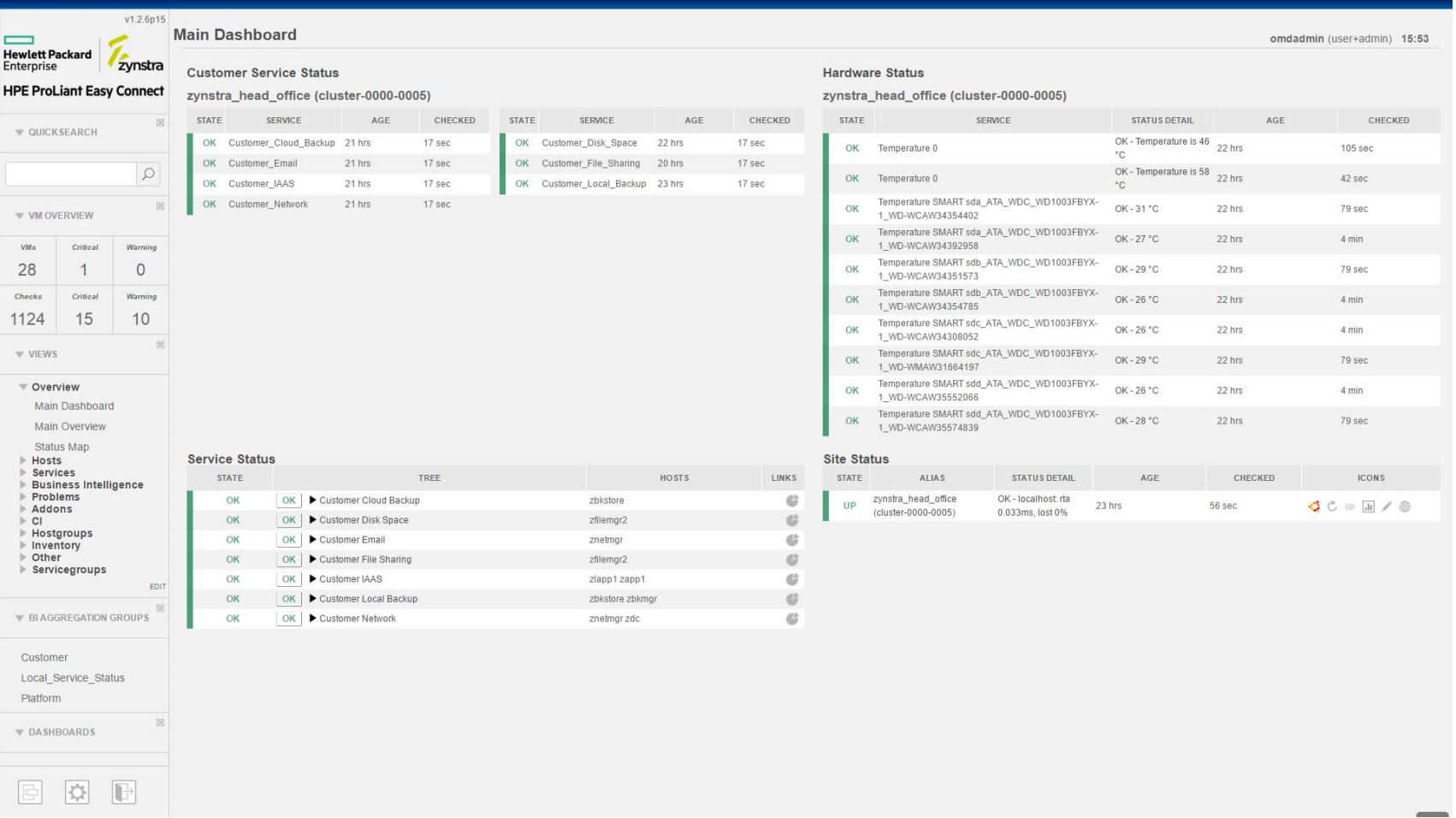
Somewhat like this, the Easy Connect EC200a had a vision of being a low-cost edge server for retail and education. HPE partnered with Zynstra here instead of a Red Hat or Canonical which are much larger in this space. Microsoft has even become much stronger in this arena with the Azure tie-in. Like the HPE ProLiant MicroServer Gen10, this solution used an embedded CPU and supported 3.5″ hard drives. The EC200a is less serviceable, more proprietary, and had less built-in expansion due to its smaller footprint.
The strange thing here is that had HPE simply made a more SMB-friendly machine that could connect to remote data centers including the cloud using standard stacks, they probably would have an enormous market and more importantly, mind share with these devices. While these are targeted at the SMB and edge space, realistically, HPE is going after a deployment environment first, then customer segments second.
The reason we like the MicroServer Gen10 Plus, even though it is not perfect, is that HPE did a much better job building a hardware platform that combined the best of both the ProLiant MicroServer Gen10 and the ProLiant EC200a.
STH Server Spider: HPE ProLiant EC200a
In the second half of 2018, we introduced the STH Server Spider as a quick reference to where a server system’s aptitude lies. Our goal is to start giving a quick visual depiction of the types of parameters that a server is targeted at.
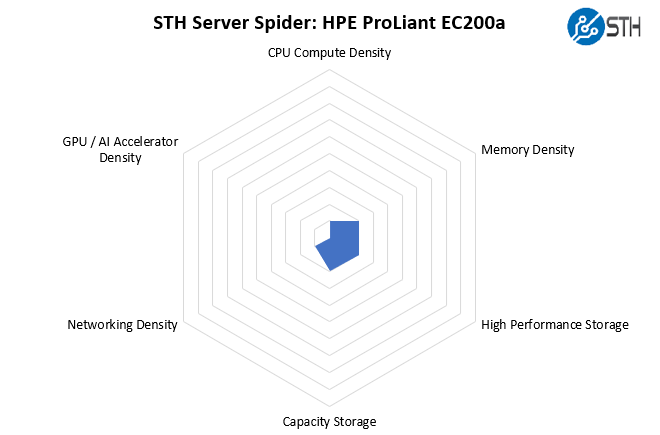
This is actually a fairly compact system, but the decision to use non-standard component sizes and a relatively large motherboard means that this system is limited in terms of density as well as expandability. That is effectively what HPE was aiming for with this system and an increase in density would likely have meant noisier cooling so this makes sense.
Final Words
There are some intriguing juxtapositions when looking at the ProLiant EC200a. We have a device that has a high-end CPU with built-in 10GbE MACs, yet the system does not offer 10GbE. We have a system that carries support contracts, paywalled firmware updates, and potentially pricey iLO license upgrades, yet the machine itself is made of plastic and plastic painted to look like metal. The system itself actually is a great form factor and has excellent options, yet the options that can be added are mostly proprietary and system-specific from the drive trays to the NIC, to the storage expansion.
Ever since we first saw the solution, it was one that makes a lot of sense in terms of an attempt to bring HPE solutions to the edge. Now, we think the HPE ProLiant MicroServer Gen10 Plus is a significantly better solution in this segment. The ProLiant EC200a is getting near the end of its lifecycle but we are seeing the space become more competitive with systems like the Lenovo ThinkSystem SE350 showing an updated view on edge computing on the higher-end.
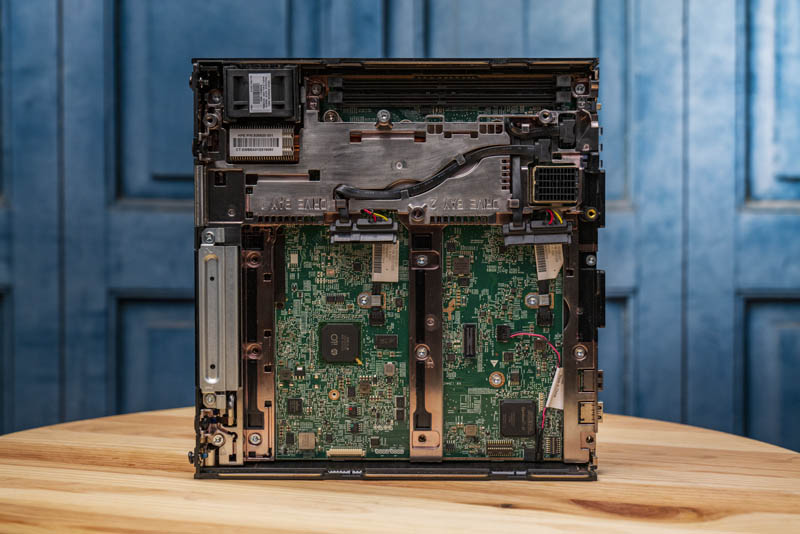
We must mention that we purchased our review unit for $150. At that price, it is absolutely an excellent value. At the same time, the $150 system (without RAM) is less than just a used Supermicro motherboard with a Xeon D-1518 from that era costs these days. The Xeon D-1518 in this system is still technically a current generation orderable part from Intel so these are not exactly “old” systems. They are still current generation CPUs inside. The embedded edge market is designed for longer lifecycles, and that is the market for the EC200a so that makes sense. What that tells us is that the HPE value proposition of this machine, over its lifetime, maybe less than its competitors. Again, we think this is mostly due to positioning, firmware availability, and some of the design directions.
The HPE ProLiant EC200a is remarkably close to being the system that an entire segment of software developers and SMB/ edge deployments dream of. For many, it is going to be the right solution. We hope that in the next few quarters, HPE takes the opportunity to present a new vision of edge computing within the HPE portfolio beyond the ProLiant MSG10+ and this EC200a.




This seems similar in spirit to the recently reviewed HP EC200A.
This is superior to the EC200A along all the dimensions that one would be considering these units (primarily CPU performance, networking, IPMI licensing cost), but the latter has been available fairly cheaply used.
Now that it’s been a few years, what does everyone seem to be using this for? It’s almost like a mini/micro pc in a larger form factor so it can take bigger physical drives.